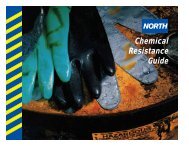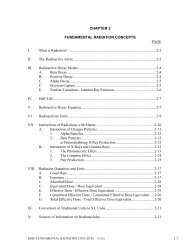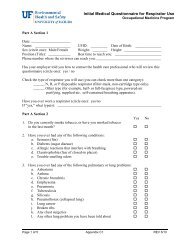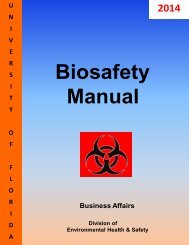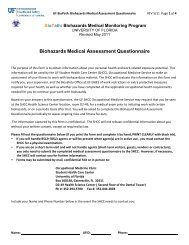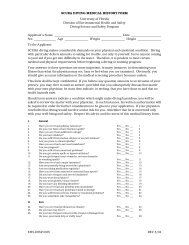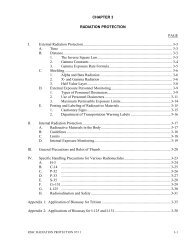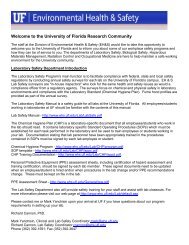APPENDIX G APPLICATION OF BIOASSAY FOR I-125 AND I-131 A ...
APPENDIX G APPLICATION OF BIOASSAY FOR I-125 AND I-131 A ...
APPENDIX G APPLICATION OF BIOASSAY FOR I-125 AND I-131 A ...
Create successful ePaper yourself
Turn your PDF publications into a flip-book with our unique Google optimized e-Paper software.
<strong>APPENDIX</strong> G<strong>APPLICATION</strong> <strong>OF</strong> <strong>BIOASSAY</strong> <strong>FOR</strong> I-<strong>125</strong> <strong>AND</strong> I-<strong>131</strong>A. CONDITIONS UNDER WHICH <strong>BIOASSAY</strong> IS NECESSARY1. Routine bioassay is necessary when an individual handles in open form,unsealed quantities of radioactive iodine that exceed those shown in Table1. The quantities shown in Table 1 apply to both the quantity handled atany one time or integrated as the total amount of activity handled by anindividual over a one month period.2. Bioassay is not required, but recommended, when process quantitieshandled by an individual are less than those in Table 1.B. PARTICIPATIONAll individuals handling radioactive iodine or sufficiently close to the process sothat intake is possible (i.e., within a few meters and in the same room as theindividual handling the material), should participate in bioassay programs.C. TYPES <strong>OF</strong> <strong>BIOASSAY</strong> THAT SHOULD BE PER<strong>FOR</strong>MED1. BaselineA baseline bioassay should be conducted prior to beginning work withradioactive iodine in amounts that would require participation in thebioassay program.2. RoutineRegular bioassay should be conducted to monitor routine operations at thefrequency specified in Section D.3. EmergencyA bioassay should be performed as soon as possible after any incident thatmight cause thyroid uptakes to exceed burdens given in Section E.1.b sothat actions recommended in Section E.1.b.(3) can be most effective.4. Post-Operational and Termination of UsageA bioassay should be performed within 2 weeks of the last possibleexposure to I-<strong>125</strong> or I-<strong>131</strong>, when operations are being discontinued orwhen the individual is terminating activities with potential exposure tothese radionuclides.5. DiagnosticFollow-up bioassay should be performed within 2 weeks of anymeasurements exceeding levels given as action points in Section E. inorder to confirm the initial results and in the case of a single intake, toallow an estimate of the effective half-life of radioiodine in the thyroid.
D. FREQUENCYInitial RoutineA bioassay sample or measurement should be obtained within 72 hours followingentry of an individual into an area where bioassay is performed in accordancewith Sections A and B and every 4 weeks or more frequently thereafter, as long asthe conditions described in Sections A and B exist. When work with radioactiveiodine is on an infrequent basis, (less frequently than every 4 weeks), bioassayshould be performed within 10 days of the end of the work period during whichradioactive iodine was handled, unless emergency action is appropriate.E. ACTION POINTS <strong>AND</strong> CORRESPONDING ACTIONS1. Monthly and Other Measurementsa. Whenever the thyroid burden at the time of measurement exceeds0.12 Ci (4.4 kBq) of I-<strong>125</strong> or 0.04 Ci (1.5 kBq) of I-<strong>131</strong>, thefollowing actions will be taken:(1) An investigation of the operations involved, including airand other in-house surveys, will be carried out to determinethe causes of exposure and to evaluate the potential forfurther exposures or for the possible involvement of otherindividuals.(2) Any evidence indicating that further work in the area mightresult in an individual receiving a dose commitment inexcess of the limits established in 64E-5.304, should serveas cause to remove the individual from work in thisoperation until the sources of exposure is discovered andcorrected.(3) Reports or notification must be provided as required by64E-5.344 and 64E-5.345 of Chapter 64E-5 or as requiredby conditions of the license.(4) Corrective actions that will eliminate or lower the potentialfor further exposures should be implemented.(5) A repeat bioassay should be taken within 2 weeks of theprevious measurement and should be evaluated within 24hours after measurement in order to confirm the presenceof internal radioiodine and to obtain an estimate ofeffective half-life for use in estimating dose commitment.b. If the thyroid burden at any time exceeds 0.5 Ci (18.5 kBq) of I-<strong>125</strong> or 0.14 Ci (5.2 kBq) of I-<strong>131</strong>, the following actions will betaken:(1) Carry out all steps in item a of this regulatory position.
(2) If the projected dose commitment exceeds levels for wholebody as provided in 64E-5.304 of Chapter 64E-5, provideappropriate notification to DOH.(3) As soon as possible, the case will be referred to appropriatemedical consultation for recommendations regardingtherapeutic procedures that may be carried out to accelerateremoval of radioiodine from the body. This should be donewithin 2-3 hours after exposure when the time of exposureis known so that any prescribed thyroid blocking agentwould be effective.(4) Carry out repeated measurements at approximately 1 weekintervals at least until the thyroid burden is less than 0.12Ci (4.4 kBq) of I-<strong>125</strong> or 0.04 Ci (1.5 kBq) of I-<strong>131</strong>.
TABLE 1ACTIVITY LEVELS ABOVE WHICH <strong>BIOASSAY</strong> <strong>FOR</strong> I-<strong>125</strong> OR I-<strong>131</strong> ISREQUIREDType of OperationProcesses in open room or bench,with possible escape of iodine fromprocess vesselsProcesses with possible escape ofiodine carried out within a fume hoodof adequate design, face velocity, andperformance reliabilityProcessed carried out withingloveboxes, ordinarily closed, butwith possible release of iodine fromprocess and occasional exposure tocontaminated box and box leakageActivity Handled inUnsealed FormMaking Bioassay Necessary*Volatile orBound to Nonvolatile AgentDispersible*1.0 mCi (37 MBq) 1.0 mCi (37 MBq)1.0 mCi (37 MBq) 10.0 mCi (370 MBq)10.0 mCi (370 MBq) 100.0 mCi (3700 MBq)*Quantities may be considered the cumulative amount in process handled by a individualduring a 1-month period; e.g., the total quantity introduced into a chemical or physicalprocess over a 1 month period, or on one or more occasions in that period, by openingstock reagent containers from which radioactive iodine may escape. Quantities in theright-hand column may be used when it can be shown that activity in process is alwayschemically bound and processed in such a manner that I-<strong>125</strong> and I-<strong>131</strong> will remain innonvolatile form and diluted to concentrations less than 0.1 mCi/mg (3.7 MBq/mg) ofnonvolatile agent. Capsules (such as gelatin capsules given to patients for diagnostictest), may be considered to contain the radioiodine in non-free form, and bioassay wouldnot be necessary unless a capsule were inadvertently opened (e.g., dropped and crushed).However, certain compounds where radioiodine is normally bound are known to releaseradioiodine when the material is in process, and the left-hand column may then beapplicable. In those laboratories working only with I-<strong>125</strong> in radioimmunassay (RIA) kits,the quantities of I-<strong>125</strong> are very small and in less volatile forms; thus, bioassayrequirements may be judged from the right-hand column. In field operations, wherereagent containers are opened outdoors for simple operations such as pouring liquidsolutions, the above table does not apply; bioassay should be performed whenever anindividual handles in open form (e.g., an open bottle or container) more than 50 mCi(1850 MBq) at any one time.Operations involving the routine use of I-<strong>125</strong> or I-<strong>131</strong> in an open room or bench arediscouraged. Whenever practicable, sealed bottles or containers holding more than 0.1
mCi (3.7 MBq) of I-<strong>125</strong> or I-<strong>131</strong> should be opened at least initially within hoods havingadequate face velocities of 150 lf/min or more.




